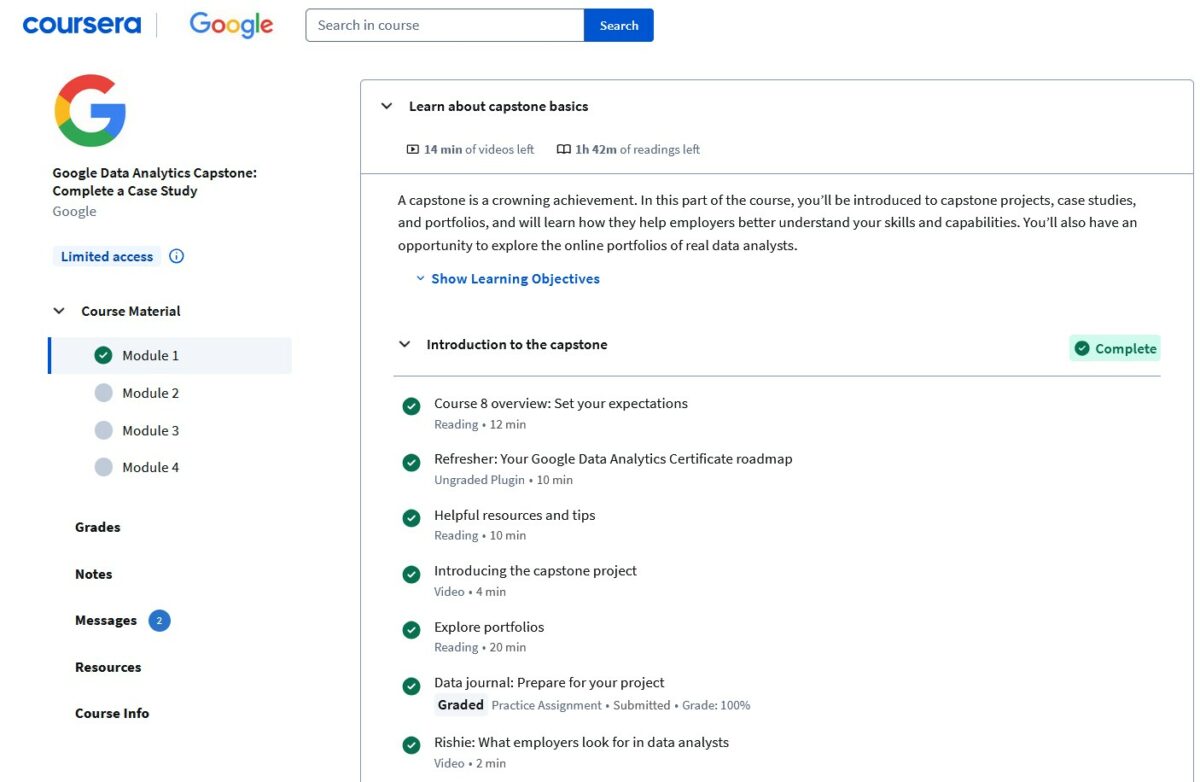Google Data Analytics Professional Certificate: My experience and review
|
Don't want to get blog posts by email any longer? Click here to receive the main newsletter, but opt out of receiving blog posts by email. I put off starting the Google Data Analytics course because I read that it was a big time commitment, and I didn’t really have time to feel like I was giving it my all. I was also a bit daunted about having to learn programming languages. I’ve now got round to starting the courses (at least), and this is my Google Data Analytics course review of the materials and the Professional Certificate. How I did this reviewI signed up for a Coursera free account and audited the class. I watched the videos and took the ungraded quizzes, working through the course materials to see what I thought of the content and the course learning management system. Key things to know
Course overviewThe Google Data Analytics professional certificate is made up of 8 courses:
There is also an optional course called Accelerate Your Job Search with AI. That’s 4 modules and is helpful if you want to learn how to use Gemini and Notebook LM for interview prep or to work on your resume or online presence. Courses 1-7 are the steps you’ll go through as a data analyst to use data to inform your decisions. The capstone project is a way to synthesize all that you have learned. The other Google Professional Certificates also have capstone projects – it’s a way of making sure that you’ve got actionable skills instead of just having the ability to pass multiple-choice assignments. Each course is made up of multiple modules – Foundations has 4, for example – and you have a graded assignment at the end of each module in order to pass. Who is this course suitable for?Is the Google data analytics certificate good for beginners? Absolutely. This course is suitable for beginners. It’s open to everyone including non-traditional learners and those without degrees. Alternatives to the Google Data Analytics CertificateIf you already have some data analysis experience, there is an alternative course aimed at people like you: Google Advanced Data Analytics. There’s also the Google Business Intelligence Certificate, which is great if you use BI a lot in your job (or would like to). There are also courses by IBM and Meta that might be a good fit for you, but I’ve had amazing experiences with other Google courses so to be honest I didn’t even look at those! How to pass the Google Data Analytics CertificateTo pass, you need to complete and pass all the mandatory courses in the certificate program, which means scoring 80% or more in each of the graded assignments. You also need to pay the course certificate fee (or pay through another method, such as Coursera Plus subscription, the Coursera financial aid program or via your employer’s subscription or sponsorship). How long does it take to complete the Google data analytics certificate??You might be wondering, what’s the time commitment? That’s certainly why I delayed starting the training. There is a lot of material to cover. The mandatory courses are advertised as taking 141 hours. You can speed up some of this by watching videos at 1.5x speed, and I’ve always found that the estimates given are a bit over-egged for my personal learning. You are going to have to put the time in. It sounds easy, but you’ll also need to commit to not giving up! If you are coming at this course from a non-mathematical, non-data background like me (as a project manager) then you have quite a steep learning curve. How hard is the Google data analytics course?For someone who hasn’t done any type of data analytics before, I found it quite hard! The Foundations module is OK, because if you have corporate experience, the material on ‘why do we need to do data-driven decision making’ is easy. But if you’re coming to the topic fresh out of school, then there is definitely a learning curve. However, the material is well-presented and each course builds on the next with plenty of revision over topics. Skills covered in the courseThe analytical skills you’ll learn in the course include these:
Although the course trainer makes it clear that you probably already have these skills already and it’s just a case of learning how to use them in a business scenario. There’s nothing in the course about stakeholder engagement, conflict resolution when two sets of customers want the data to show different things, working with project managers or business analysts or any of the other multitude of soft skills that will make it easier for you to do the job. There are other courses that teach that, so you can learn soft skills elsewhere, just don’t expect to cover them in this certificate. Interactivity and engagement: learning with CourseraI like the Coursera platform. The videos are well-produced in the Google courses, with engaging quizzes and hands on labs. There are plugins, templates, downloads, glossaries and other resources that help you learn. There’s also the community, so if you get stuck or just want to hang out with other learners, there is that option too.
The data journalDuring the course, you’ll create a data journal which is a useful place to put your reflections and learnings. The course includes a template and reflection prompts, so you can complete it as you go along. What tools are used in the Google data analytics course?You’ll use Google Sheets, Google Docs, Kaggle, SQL, R, Tableau, Google Slides, and some AI tools like Notebook LM and Gemini if you take the AI course. Does the Google data analytics certificate teach Python?No, the training does not cover Python, so if you want to learn that, it would be best to take another course. There is the Google IT Automation with Python Professional Certificatethat does cover Python, so check that one out. The Capstone projectPeople worry about the Google Professional Certificate capstone projects, and this one is a big project. You have two options to work through the case study, either using existing questions and data sets or choosing your own data. If you don’t have any professional experience to draw from, I’d recommend using their dataset (Track A) so you have data to get started from. There are two options within Track A: a case study on bicycle trip data or one on fitness tracker data. Track B is where you can use your own data to create a case study path – better if you have a job where you can use a real business problem. However, you have to use a publicly available dataset that focuses on an area of interest so it’s not possible to use corporate confidential information for your case study. I mean, you could if you wanted, but it’s probably best not to as you’re submitting it for the world to see. As part of the Google data analytics capstone project, you’ll create a Kaggle profile and notebook, which is where you’ll put your portfolio content. However, it’s worth noting that the Capstone project is optional. You don’t have to complete it in order to earn the certificate.
Overall pros and cons of the Coursera Google Data Analytics coursesThe advantages of doing this professional certificate from Google are:
The disadvantages are:
Will you get a job?Finally, we need to address this: Can you get a job with Google data analytics certification?Well, I can’t say if you as an individual will get a job, but as an employer I can say that I would think highly of this certificate but it wouldn’t be the only thing I’d look for. Additional work experience and interpersonal skills are also important. Maybe use your new data analytics skills to take on some small projects in your existing job, or do some volunteer work, or use publicly available datasets, so you’ve got some examples to talk about at interview.
Is the Google Data Analytics Certificate worth it?Yes, my conclusion is the data analytics certificate is worth it if you are in a job where you need to work with data (so, lots of jobs) or if you want to make data analytics the core of your professional career and are just starting out or want to job switch into that kind of role. It will help you get an entry level job and talk knowledgeably at interview but it will not equip you with enough hands-on practical skills to feel like you could easily get started in a job. I think you’d still need a bit of hand-holding and live experience to feel properly confident. Once you’ve learned the material, there is nothing to stop you using the tools in your spare time to get better, and build a portfolio you can use at interview. But you’ll have to put extra time in for that. Cheapest way to get the Data Analytics certificateI hope you’ve found this Google Data Analytics certification review useful! If you’re ready to sign up yourself, the best and cheapest way to get the Google career certificate in data analytics is to join Coursera Plus. Audit the courses first to do as much of the learning as you can – or at least make a start without paying anything. Then sign up for Coursera Plus and complete as much as you can during the free 7-day trial. Then you won’t have to pay for Plus access for too long! Other Coursera Certificate reviewsI’ve been a long-time fan of Coursera and the courses you can do there. Check out these other reviews of courses and professional certificates you might find useful:
|
Calling all Rebel Project Managers!
I help project professionals get more done with less stress. Having been a project manager for over 20 years, I share tried-and-tested tips that work in the real world, every Tuesday. Join our community of over 15,000 project professionals (and accidental project managers too!).
Hello Reader, Most people I speak to are managing more than one project – that’s just life these days as a PM. I like the variety, but the workload… not so much. I put together a webinar a while back that shared my top 5 tips for managing multiple projects. You can watch the replay – there’s no registration or login required. In the webinar, I talk about the key things that make it easier to juggle all the projects: Milestone planning Dependency management Multi-stakeholder management...
Hello Reader, It's International PMO Day today. This is a relatively new day, I think it started last year. International Project Management Day (November) has been around for many years, so why shouldn't PMOs get their chance to shine too? How to set up a PMO was one of the questions that people came back to me with when I asked what you’d like help on a couple of weeks ago. I wouldn’t call myself a PMO expert, although I have run a team of PMs in the past, so I turned to my friend Bill Dow...
Hello Reader, I’m a firm believer in doing one thing at a time… OK – that pretty much never works in practice, but I do try to have a goal of 1-3 tasks per day. Today was all about project communications. I don’t need to tell you how important it is to have a communications plan for your project (do I?). It’s something you should set up at the beginning of your project, and then review and tweak all the way through because: Stakeholders change and you don’t want to miss anyone out...



